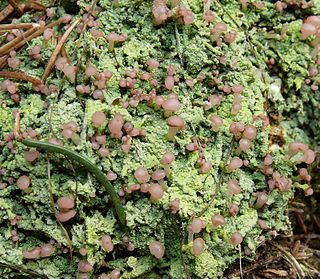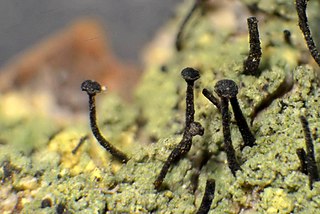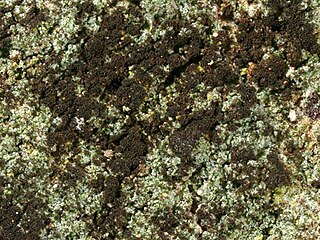
The Botryosphaeriaceae are a family of sac fungi (Ascomycetes), which is the type representative of the order Botryosphaeriales. According to a 2008 estimate, the family contains 26 genera and over 1500 species. Members of this order include notable plant pathogens.

The Arthoniales is the second largest order of mainly crustose lichens, but fruticose lichens are present as well. The order contains around 1500 species, while the largest order with lichenized fungi, the Lecanorales, contains more than 14000 species.

The Arthoniaceae are a family of lichenized, lichenicolous and saprobic fungi in the order Arthoniales. The Arthoniaceae is the largest family of Arthoniales, with around 800 species. Most species in Arthoniaceae belong in Arthonia which is the largest genus with 500 species. The second and third largest genus is Arthothelium with 80 species, and Cryptothecia with 60 species.

The Baeomycetales are an order of mostly lichen-forming fungi in the subclass Ostropomycetidae, in the class Lecanoromycetes. It contains 8 families, 33 genera and about 170 species. As a result of molecular phylogenetics research published in the late 2010s, several orders were folded into the Baeomycetales, resulting in a substantial increase in the number of taxa.

The Graphidaceae are a family of lichen-forming fungi in the order Graphidales. The family contains nearly a hundred genera and more than 2000 species. Although the family has a cosmopolitan distribution, most Graphidaceae species occur in tropical regions, and typically grow on bark.
Roccellina is a genus of lichen-forming fungi in the family Roccellaceae.

Chrysothrix is a genus of lichen-forming fungi in the family Chrysothricaceae. They are commonly called gold dust lichens or sulfur dust lichens, because they are bright yellow to greenish-yellow, sometimes flecked with orange, and composed entirely of powdery soredia. Apothecia are never present in North American specimens.

The Caliciaceae are a family of mostly lichen-forming fungi belonging to the class Lecanoromycetes in the division Ascomycota. Although the family has had its classification changed several times throughout its taxonomic history, the use of modern molecular phylogenetic methods have helped to establish its current placement in the order Caliciales. Caliciaceae contains 39 genera and about 670 species. The largest genus is Buellia, with around 300 species; there are more than a dozen genera that contain only a single species.

Lecanographaceae is a family of mostly lichens in the order Arthoniales. The family was circumscribed in 2014, prompted by a molecular phylogenetic-based restructuring of the Arthoniales.

Bilimbia is a genus of lichen-forming fungi in the family Ramalinaceae.
Crypthonia is a genus of lichen-forming fungi in the family Arthoniaceae. It has 16 species. The genus was circumscribed in 2010 by Andreas Frisch and Göran Thor, with Crypthonia polillensis assigned as the type species.
Marcelaria is a genus of crustose lichens in the family Trypetheliaceae. It has three species. The genus was circumscribed in 2013 by André Aptroot, Matthew P. Nelsen, and Sittiporn Parnmen, with Marcelaria purpurina assigned as the type species. The genus contains species that were previously in the Laurera purpurina species complex. Species in Marcelaria contain secondary compounds such as red, orange, and yellow anthraquinones, and sometimes lichexanthone. The genus name honours Brazilian lichenologist Marcela Cáceres.
Myriostigma is a genus of lichens in the family Arthoniaceae. The genus was circumscribed by German lichenologist August von Krempelhuber in 1874.
Inoderma is a genus of lichen-forming fungi in the family Arthoniaceae. It was resurrected for use in 2015 for a small group of species with the following features: elevated, white pruinose pycnidia, immersed to adnate white pruinose apothecia, and a weakly gelatinized hymenium. Inoderma byssaceum was assigned as the type species for the genus.

Reichlingia is a genus of lichen-forming fungi in the family Arthoniaceae. It has seven species. The genus was originally circumscribed by Paul Diederich and Christoph Scheidegger in 1996, with Reichlingia leopoldii as the type, and at that time, only species. The fungus was at first thought to be a lichenicolous (lichen-dwelling) fungus, but is now considered a lichenised hyphomycete.
Gyronactis is a genus of lichen-forming fungi in the family Roccellaceae. It has two species. The genus was circumscribed by Damien Ernst and Anders Tehler in 2014, with G. asiatica assigned as the type species. This lichen, formerly placed in Lecanactis, is only known from the type locality in Myanmar. The genus name alludes to both its similarity with Lecanactis and the presence of gyrophoric acid in the thallus.
Melarthonis is fungal genus in the family Chrysotrichaceae. It is a monotypic genus, containing the single species Melarthonis piceae, a corticolous lichen. Both the genus and species were described as new to science in 2014 by Andreas Frisch and Göran Thor. The type specimen was collected from Mount Oakan at an altitude of 420 m (1,380 ft); there, it was found growing on the bark of a spruce tree in an old-growth forest. It is only known to occur in the type locality. The genus name alludes to the black ascomata that are similar to those in genus Arthonia, while the species epithet refers to the genus of the host tree (Picea).
Galbinothrix is a fungal genus in the family Chrysotrichaceae. It is monotypic, containing the single species Galbinothrix caesiopruinosa, a corticolous (bark-dwelling) lichen.
Fouragea is a genus of lichen-forming fungi in the family Opegraphaceae. It has nine species.

Coniocarpon is a genus of lichen-forming fungi in the family Arthoniaceae. It has eight species of corticolous (bark-dwelling) lichens. This genus is distinct for its crystalline orange, red, and purple quinoid pigments in the ascomata that turn purple in potassium hydroxide solution, its colourless, transversely septate ascospores with large apical cells, and its rounded to lirellate ascomata.











